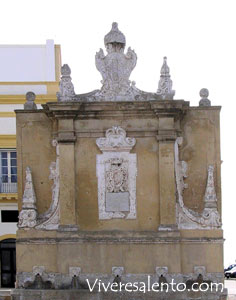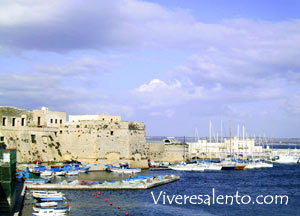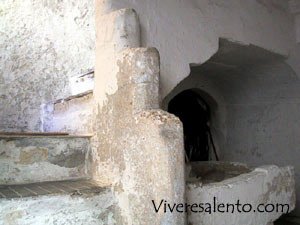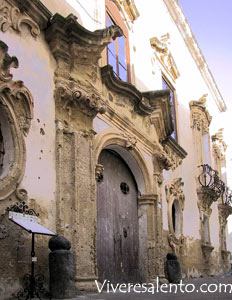|
|

| Inhabitants's name: Gallipolini |
The civic coat of arms of Gallipoli is
marked by a cock and a Latin inscription that means "watch over
 faithfully."
The toponym derives, probably, from the Greek "Kalos- Polis" that is, "beautiful
town." As the origins of Gallipoli are concerned the town might have been
founded by some people coming from a near village, Alezio. Unfortunately there
is no paper that can prove the origins of Gallipoli, so there are only some
legendary theories. For instance, for some historians, Idomeneo , after the war
of Troy, took refuge on the coasts of the Salento and founded Gallipoli; the
cock of the civic coat of arms was engraved on his shield. According to an other
hypothesis, the town was founded in the IV century B.C. by some Greek coming
from Sicily: they decided to engrave the cock on the coat of arms since they
believed that the animal had protected them during the trip. In 265 B.C.
Gallipoli was under the Roman domination. The Vandals destroyed it in 450 B.C.
and in 542 B.C. Totila razed it to the ground again. By the middle of the VI
century A.C. it was reconstructed by the Greek of the East Roman Empire: they
abolished the Latin rite and imposed the Greek one, that was performed until the
XVI century. During the Greek domination Gallipoli became very important for the
ships. The Longobards never succeed in conquering this town , but in the XI
century the Normans, led by Beomondo faithfully."
The toponym derives, probably, from the Greek "Kalos- Polis" that is, "beautiful
town." As the origins of Gallipoli are concerned the town might have been
founded by some people coming from a near village, Alezio. Unfortunately there
is no paper that can prove the origins of Gallipoli, so there are only some
legendary theories. For instance, for some historians, Idomeneo , after the war
of Troy, took refuge on the coasts of the Salento and founded Gallipoli; the
cock of the civic coat of arms was engraved on his shield. According to an other
hypothesis, the town was founded in the IV century B.C. by some Greek coming
from Sicily: they decided to engrave the cock on the coat of arms since they
believed that the animal had protected them during the trip. In 265 B.C.
Gallipoli was under the Roman domination. The Vandals destroyed it in 450 B.C.
and in 542 B.C. Totila razed it to the ground again. By the middle of the VI
century A.C. it was reconstructed by the Greek of the East Roman Empire: they
abolished the Latin rite and imposed the Greek one, that was performed until the
XVI century. During the Greek domination Gallipoli became very important for the
ships. The Longobards never succeed in conquering this town , but in the XI
century the Normans, led by Beomondo of Altavilla, took possession of the town and tried to replace the Greek rite
with the Latin one. The Normans were succeeded by the Swabians, and in 1269 by
the Angevins that destroyed the town, thus causing a lot of people to take
refuge in the neighbouring villages. In the XIV century Gallipoli was
incorporated into the Principality of Taranto, and a slow process of
repopulation began. In 1463 Ferdinand I of Aragon fortified the town, that
however was attacked and defeated by the Venetians in 1484. The following year,
the Aragoneses conquered it again. In the XVI century after the Spanish
domination there was the French one (1528). The French however were defeated by
the inhabitants in a short time. Later Gallipoli was incorporated into the
Kingdom of Naples. Frederic II of
of Altavilla, took possession of the town and tried to replace the Greek rite
with the Latin one. The Normans were succeeded by the Swabians, and in 1269 by
the Angevins that destroyed the town, thus causing a lot of people to take
refuge in the neighbouring villages. In the XIV century Gallipoli was
incorporated into the Principality of Taranto, and a slow process of
repopulation began. In 1463 Ferdinand I of Aragon fortified the town, that
however was attacked and defeated by the Venetians in 1484. The following year,
the Aragoneses conquered it again. In the XVI century after the Spanish
domination there was the French one (1528). The French however were defeated by
the inhabitants in a short time. Later Gallipoli was incorporated into the
Kingdom of Naples. Frederic II of
 Bourbon
was very fond of the town so, he made the harbour building finish. The most
important native characters of Gallipoli are several, one of them is Antonietta
De Pace. She was born in 1818 and belonged to a wealthy family; she was brought
up by her sister and her brother-in-law since her parents died when she was only
eight. Her brother-in-law, Epaminonda Valentini was one of Mazzini's supporters
and he transmitted her all the Renaissance ideas. After his death ( in the jail
of Lecce in miserable conditions), Antonietta moved to Naples to struggle
against the Bourbons. She helped Giuseppe Mazzini a lot and she collected funds
for Garibaldi's mission. In 1866 she spent terrible moments for the death of her
nephew, Francesco; she died some years later in 1893 at Capodimonte after her
dream had come true: the Unity of Italy. Giuseppe Tricarico was born in 1623, he
became a musician after studying in Naples. He became very famous when the
Empress of Austria invited him Bourbon
was very fond of the town so, he made the harbour building finish. The most
important native characters of Gallipoli are several, one of them is Antonietta
De Pace. She was born in 1818 and belonged to a wealthy family; she was brought
up by her sister and her brother-in-law since her parents died when she was only
eight. Her brother-in-law, Epaminonda Valentini was one of Mazzini's supporters
and he transmitted her all the Renaissance ideas. After his death ( in the jail
of Lecce in miserable conditions), Antonietta moved to Naples to struggle
against the Bourbons. She helped Giuseppe Mazzini a lot and she collected funds
for Garibaldi's mission. In 1866 she spent terrible moments for the death of her
nephew, Francesco; she died some years later in 1893 at Capodimonte after her
dream had come true: the Unity of Italy. Giuseppe Tricarico was born in 1623, he
became a musician after studying in Naples. He became very famous when the
Empress of Austria invited him to Vienna, where he stayed for five years; he died in Italy in 1697. Giovanni
Andrea Coppola was born in 1597, he was a physician and a brilliant artist. His
paintings can be seen in many churches of the Salento; he died in 1659. Giovanni
Presta was born in 1720, he was a physician and an agronomist; for his zeal and
his cleverness the Empress Catherine II and Ferdinando IV gave him a medal. He
died in the 1797 in his native town, after devoting himself to the study of the
agrarian goods of his time: the oil and the tobacco.
to Vienna, where he stayed for five years; he died in Italy in 1697. Giovanni
Andrea Coppola was born in 1597, he was a physician and a brilliant artist. His
paintings can be seen in many churches of the Salento; he died in 1659. Giovanni
Presta was born in 1720, he was a physician and an agronomist; for his zeal and
his cleverness the Empress Catherine II and Ferdinando IV gave him a medal. He
died in the 1797 in his native town, after devoting himself to the study of the
agrarian goods of his time: the oil and the tobacco.
|